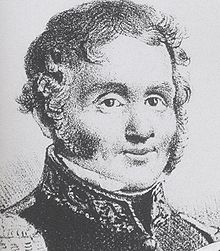Vicente Filisola
Vicente Filisola (* 1789 in Ravello , Italy , † 1850 in Mexico City ) was a Mexican general and captain general of Central America .
Life
Filisola came to Spain at an early age - probably together with his family . He seems to have been naturalized there. In any case, he is listed as a Spaniard in later documents.
Military advancement
At the age of 15, on March 17, 1804, Filisola signed up for the Spanish army. In 1811 he was posted to New Spain (Mexico) - now with the rank of sub-lieutenant - where the independence war was in full swing since the priest Miguel Hidalgo's appeal for independence ( Grito de Dolores ) on September 16, 1810 . He was appointed captain of the artillery in 1813 and grenadier captain in 1814 .
During this time Filisola met Agustín de Iturbide , with whom he developed a personal friendship in the following years . So in 1820 he joined the rebellious Mexicans and supported his " Plan of Iguala " and finally his rise to Emperor Agustín I. This friendship and support helped Filisola achieve a rapid military rise. In 1821 he was appointed brigadier general and commander of the " Trigarante Army ".
Captain General of Central America
On September 15, 1821, Central America had also declared itself independent. Following the declaration of independence, however, a discussion broke out between conservatives and liberals as to whether Central America - as Gabino Gaínza and the conservatives wanted - should join the Mexican Empire on the basis of the "Plan of Iguala" or an independent federal state modeled on the USA should form. To support Gaínza, Agustín I. ordered Filisola with 600 men to the border with Chiapas , which at that time still belonged to Central America. Thereupon Gaínza declared with a decree of January 5, 1822 the annexation of Central America to the Empire of Mexico and Agustín I appointed him captain general ( military governor ) of Central America.
This solved in El Salvador under the leadership of Dr. Matías Delgado and Manuel José Arce met with massive resistance. The Liberals in El Salvador declared the annexation to Mexico ineffective and El Salvador independent and mobilized an armed resistance. Since Gabino Gaínza did not get the situation in El Salvador under control, Agustín I appointed Filisola as captain general of Central America and ordered him to move to El Salvador with the troops stationed on the border and put down the resistance. On June 23, 1822, Gaínza gave him government power in Guatemala City .
Filisola then turned with his troops to El Salvador, where he won the decisive victory over the rebellious liberals on February 9, 1823. After returning to Guatemala City, however, he received news of the abdication of Agustín I on March 19. In view of this fact, he no longer opposed the renewed declaration of independence and the proclamation of the "United Provinces of Central America" on July 1, but tried on his part to stay in power as the head of government of an independent Central America. In the end, however, after only ten days he had to hand over government affairs to a provisional government junta under the leadership of doctor Dr. Surrender to Pedro Molina and withdraw to Mexico with his troops.
The Texan War of Independence
Despite his close relationship with Agustín de Iturbide, Filisola managed to continue to hold important positions in the army and administration of the young Republic of Mexico even after his fall. Among other things, he was appointed commander of the eastern Provincias Internas in 1833 .
When Texas declared its resolution of Mexico in mid-1835 , the Mexican President, General Santa Anna , appointed Filisola to be his deputy to command the Mexican forces . He took part in the battles of Gonzales and Alamo , among others . When Santa Anna was captured by the Texans on April 22, 1836, the day after the devastating defeat at the Battle of San Jacinto , Filisola was given the task of organizing the retreat of the Mexican troops. On Santa Anna's orders, Filisola evacuated San Antonio , ratified the " Treaty of Velasco " concluded by Santa Anna and set the troops on the march towards Matamoros . On May 28, the new Mexican government under President José Justo Corro (Santa Anna had since been deposed) ordered him not to vacate conquered territories. Filisola then initially agreed to retake areas that had already been cleared, but then decided, due to the condition of his troops, to continue the retreat to Matamoros. On June 12, Filisola was relieved of command of the Mexican troops and withdrew to Saltillo . Because of the unauthorized withdrawal, he was tried in a court-martial in Mexico, but acquitted in June 1841.
In the Mexican-American War , Filisola commanded one of the three Mexican divisions . Two years after the end of this war, he died of cholera in Mexico City .
Web links
- Vicente Filisola on the homepage of the Guatemalan government
- Vicente Filisola on the Salvadoran government website
- Vicente Filisola in "The Handbook of Texas Online"
literature
- Hector Gaitán A .: Los Presidentes de Guatemala. Artemis & Edinter, Guatemala 1992, ISBN 84-89452-25-3
| predecessor | Office | successor |
|---|---|---|
| Gabino Gaínza y Fernández de Medrano |
Presidents of Central America July 1, 1823 - July 10, 1823 |
Government junta |
| predecessor | Office | successor |
|---|---|---|
| José Matías Delgado y de León |
Head of State of the Province of El Salvador February 9, 1823–7. May 1823 |
Felipe Codallos |
| personal data | |
|---|---|
| SURNAME | Filisola, Vicente |
| BRIEF DESCRIPTION | Mexican general |
| DATE OF BIRTH | 1789 |
| PLACE OF BIRTH | Ravello , Italy |
| DATE OF DEATH | 1850 |
| Place of death | Mexico city |
